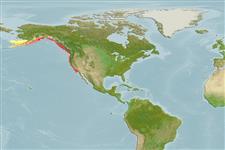Actinopterygii (ray-finned fishes) >
Scorpaeniformes (Scorpionfishes and flatheads) >
Agonidae (Poachers) > Bathyagoninae
Etymology: Odontopyxis: Greek, odous = teeth + Greek, pyxis = box (Ref. 45335).
Environment / Climate / Range
Ecology
Marine; demersal; depth range 9 - 373 m (Ref. 2850). Subtropical, preferred ?; 62°N - 32°N, 172°W - 117°W (Ref. 57310)
Eastern Pacific: southeastern Alaska to Isla Cedros, central Baja California, Mexico.
Size / Weight / Age
Maturity: Lm ? range ? - ? cm
Max length : 9.5 cm TL male/unsexed; (Ref. 2850)
Dorsal
spines
(total): 3 - 6;
Dorsal
soft rays
(total): 5-7;
Anal
spines: 0;
Anal
soft rays: 5 - 7. Caudal fin small and rounded; anal fin slightly in advance of second dorsal; pectorals broad, lower 5 to 7 rays free of membrane at end; pelvic fins reduced (Ref. 6885). Gray to olive green on the dorsal surface, lighter ventrally; 6 or more dark saddle-like markings on back and sides; dusky cross bars on dorsal, caudal and pectoral fins; anal and pelvic fins pale (Ref. 6885).
Found on soft bottoms (Ref. 2850).
Life cycle and mating behavior
Maturity | Reproduction | Spawning | Eggs | Fecundity | Larvae
Eschmeyer, W.N., E.S. Herald and H. Hammann, 1983. A field guide to Pacific coast fishes of North America. Boston (MA, USA): Houghton Mifflin Company. xii+336 p. (Ref. 2850)
IUCN Red List Status (Ref. 115185)
CITES (Ref. 94142)
Not Evaluated
Threat to humans
Harmless
Human uses
Aquarium: public aquariums
More information
Common namesSynonymsMetabolismPredatorsEcotoxicologyReproductionMaturitySpawningFecundityEggsEgg development
ReferencesAquacultureAquaculture profileStrainsGeneticsAllele frequenciesHeritabilityDiseasesProcessingMass conversion
Tools
Special reports
Download XML
Internet sources
